Gunsan, a harbor city on the west coast, transformed from a poor fishing village into an international trade hub amid the turmoil of modern history. The unvarnished image of Gunsan, where so many stories still seem to simmer below the surface, steadily resists the speed at which cities change so easily today.
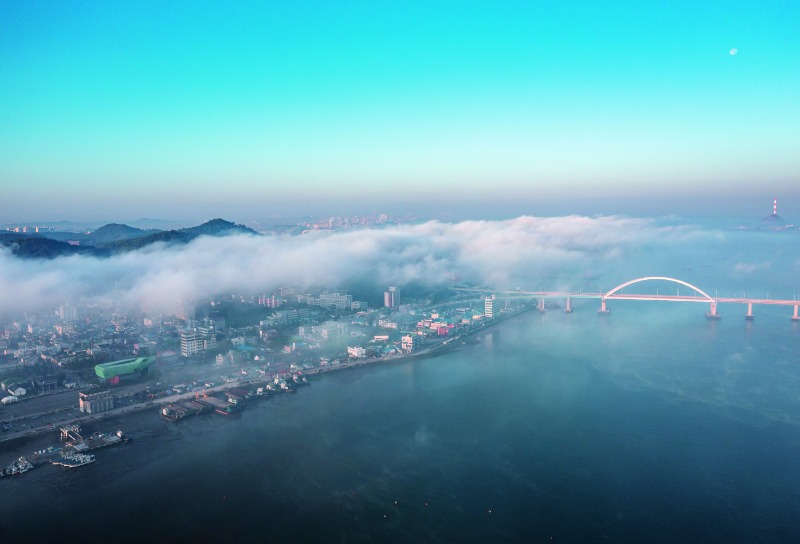
In the early 1900s, foreign culture, most notably that of Japan, was introduced to Korea through Gunsan, just upstream from the West Sea [Yellow Sea]. The exposure has left indelible reminders, some of them sobering. But that buttresses Gunsan’s uniqueness, making it a popular tourist destination.
When I set out for Gunsan, in North Jeolla Province, I thought of a bowl of hot jjamppong, the spicy, red noodle soup that fuses Chinese, Japanese and Korean cuisine. It contains a robust mixture of ingredients, including stir-fried vegetables, seafood and meat. When Koreans talk about an especially vivid potpourri, it’s dubbed “jjamppong.” Fittingly, Gunsan is noted for its version of the dish.
The bullet train from Seoul doesn’t cover the entire 200 kilometers southwest to Gunsan. Transfer is needed at Iksan, a major railway junction, to a slow, old train that travels the last 20 kilometers. The passenger cars creak and rattle, the peeling paint slips a little more, and a peculiar odor suggests a multitude of years of passenger service. It could have been a time machine that I had imagined.
Perhaps that explains how I decided on the first place to see in Gunsan, where past and present are suffused in a montage of historical reminders and enduring memories.
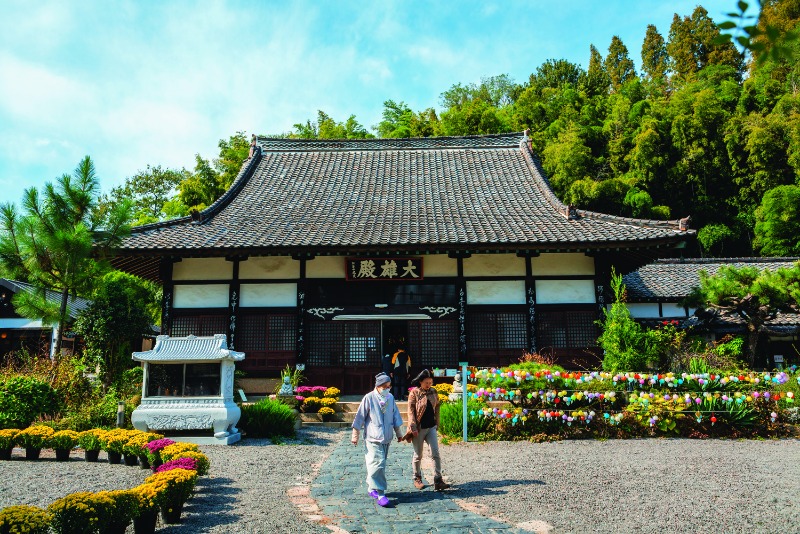
Founded by a Japanese monk in the early 20th century, Dongguk Temple is the only Japanesestyle Buddhist temple left in Korea. Construction materials were brought from Japan, and the original form of each building, including the main hall, remains well preserved today, with its decidedly austere rather than ornate aura still intact.
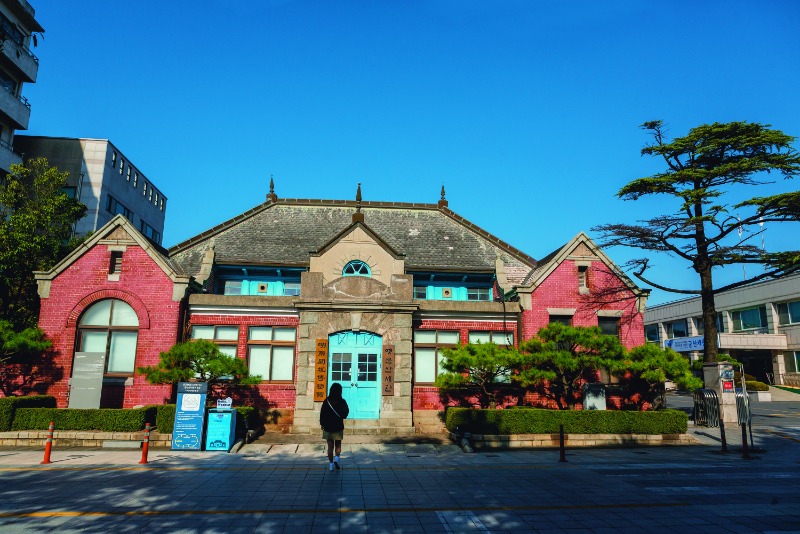
This building served as the main wing of the Gunsan Customs House from 1908 to 1993, processing seabound exports. It is now an exhibition hall. One of the three major examples of Western classical architecture in Korea, the building is a state-designated piece of Modern Cultural Heritage.
TIME TRAVEL
In its halcyon days, trains regularly ran through Gyeongamdong Railroad Town, carrying wood and paper between Gunsan Station and a paper factory. The railroad tracks are no longer used by the city’s 270,000 inhabitants, and when the trains came to a standstill, so did time in this urban village. Remaining here today is a display of school uniforms from the 1960s and 1970s, along with snacks and sundry knickknacks from bygone days. I lingered for a good while, walking along the quiet tracks. The scent of vanishing time tickled the end of my nose, threatening to bring on tears.
Leaving Gyeongamdong, I decided to refuel with a bowl of jjamppong before embarking on a proper exploration of Gunsan. The port city boasts a roster of restaurants known countrywide for this specialty noodle dish. I chose Binhaewon. Housed in a 70-year-old building that has been designated as cultural heritage, its jjamppong is tame enough for palates that don’t embrace spicy food. Combined with the old-fashioned atmosphere of the place, the soup with its mellow flavor from fresh seafood provided deep comfort for the soul – the flavor of time boiled down to its essence.
My stomach now comfortably full, I wanted to feel the energy of the past, when Gunsan anchored the most productive rice-growing region in the nation and bustled with commerce and trade. I headed for Modern History Culture Street, which abounds with examples of early modern architecture.
As I looked around the Gunsan Modern History Museum, the Modern Architecture Museum and the Modern Art Museum, I found the drive and vitality of the city still alive and realized that things left by time and history are imbued with a unique creative quality. How can something worn and faded by time still be beautiful? Slivers of architectural beauty can be seen in the vintage aura of old streets that have endured through history. I had vague glimpses of the traces of attempts to achieve beauty rather than just focus on function.
The building with the most elegant architectural charm is the old customs house, where rice was once collected for transport on the Geum River, which runs through Gunsan before spilling into the West Sea [Yellow Sea], a short distance away. The warehouses were first built centuries ago during the Goryeo Dynasty.
Gunsan had remained a small fishing village for a long time. But it was a natural choice to be turned into a port when Japan began to pressure Korea for rice. The fertile Honam Plain surrounding Gunsan yielded harvests that saturated warehouses, and the city began to handle foreign trade at the dawn of the 20th century. Many Japanese resided here during the colonial period and influenced the city’s development.
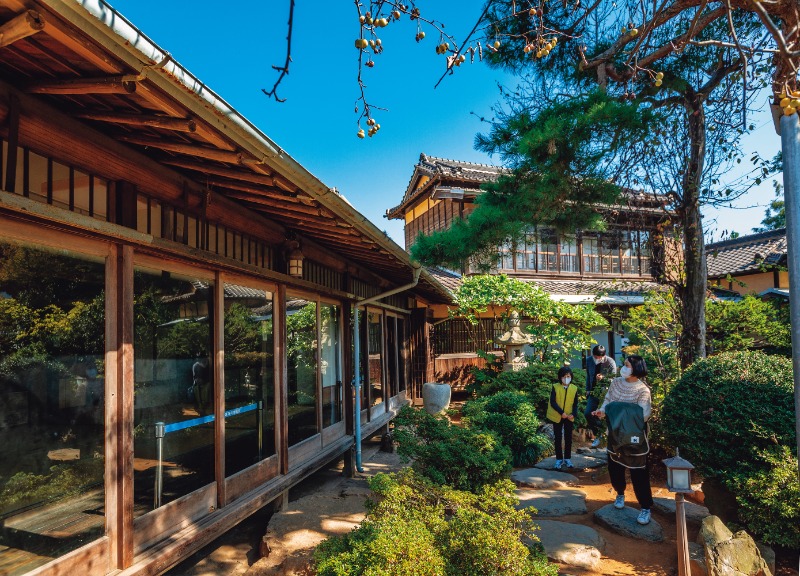
This is the old house of Keisaburo Hirotsu, a Japanese merchant who became wealthy by operating a dry goods shop in Gunsan. It is a typical Japanese samurai house of the 1920s, with its original form well preserved. The large garden and the grand exterior give an idea of the lifestyle of the wealthy Japanese upper class in those days.
DISPARATE HARMONY
The Gunsan Customs House was designed by a German, built by the Japanese with red bricks from Belgium, and has a Romanesque window, English-style entry and a Japanese-style roof. Surely this must be a prime example of jjamppong architecture in Gunsan. Standing in front of the building, I felt a range of emotions.
Today, Gunsan remains an active p in international trade and continues to handle rice shipments. Americans, not the Japanese, are the largest foreign presence. The U.S. Air Force operates an air base here.
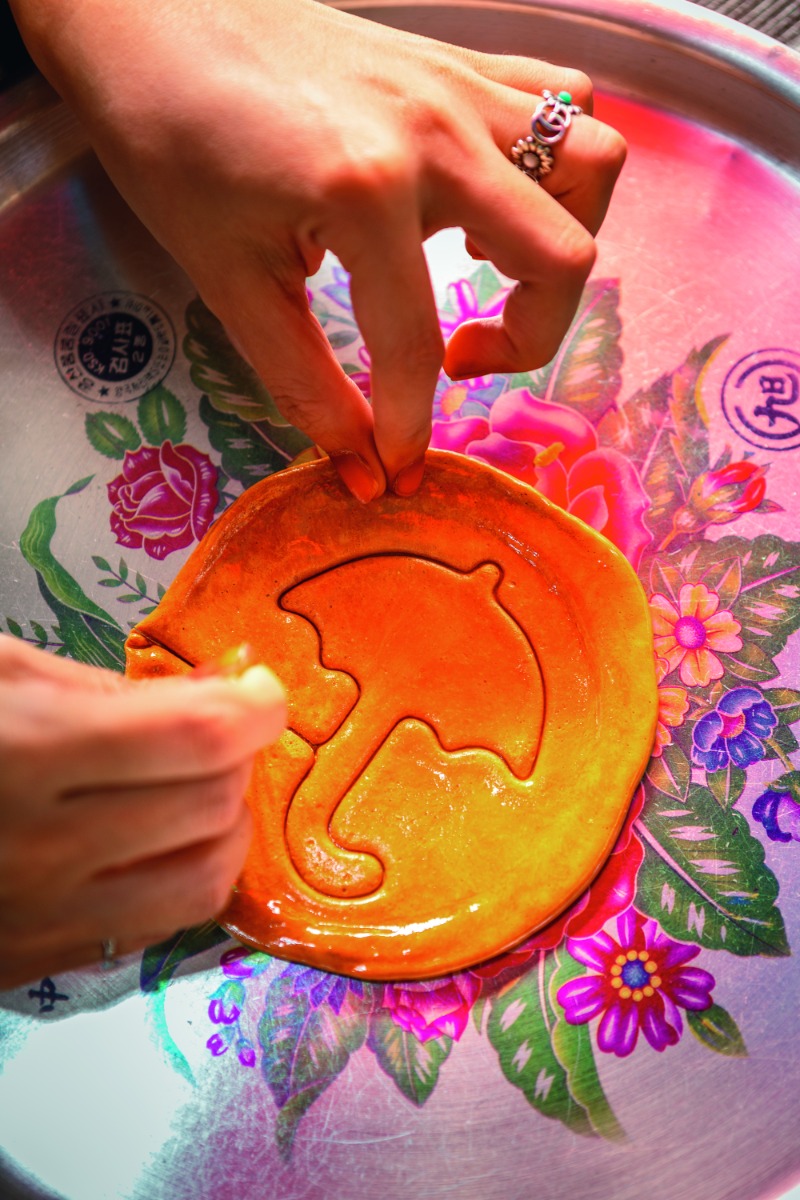
In this section of Gunsan, called Gyeongamdong Railroad Town, there are a myriad of foods and games from the past that trigger sweet memories. These days, lines form for dalgona, the honeycomb candy featured in the Netflix blockbuster series “Squid Game.”
Not far from Modern History Culture Street is Dongguk Temple. At a glance, its ambience differs from that of other Korean temples. Since it was built during the colonial period, the architectural style is obviously Japanese and the unadorned yet stylish main hall reflects Japanese minimalism. The small temple sits comfortably, with a bamboo forest at the foot of Mt. Wolmyeong as its backdrop.
In the courtyard is Sonyeosang, literally “statue of a girl” but more commonly known as the “Statue of Peace.” The statue is a reminder of the imperial Japanese military carrying away young Korean women and girls to serve as sex slaves. During the colonial period, Japanese landowners exploited sharecroppers in the Gunsan region in order to take as much rice as possible. Eventually, the sharecroppers rose up in revolt.
As I spent time in the hushed courtyard of a religious facility that has endured the storms of history, I felt a strange sense of liberation. Though ironic, it was perhaps because all the futile hatred of the past had vanished. Maybe this was why all the things left intact at the temple seemed in harmony to me rather than looking awkward.
The same feeling came over me at the Japanese-style house in Sinheung-dong. Although it’s just a private home once occupied by a wealthy Japanese businessman, this is also a lovely place that has weathered the tempests of time. The picturesque garden and the inner wing with large windows ref lect human desires for beauty. In the nearby Wolmyeong-dong area, the worn bricks, narrow alleyways and rusted metal gates vaguely recall another era. In the face of those remaining traces of turbulent history, I thought about the meaning of things that stay the same over a long period of time. It surely is comforting to observe the silence of the things that don’t change in a world that keeps changing at the speed of light.
Dazzled by time travel, I headed for Korea’s oldest bakery, Lee Sung Dang. It opened during the Japanese occupation, catering to Japanese patrons who were fond of Western bread and baked goods. I tried the bread filled with red bean paste (danpatppang) and vegetable bread (yachaeppang), the bakery’s signature menu items, and relished the tastes of past and present blending on my palate.
All over Gunsan, several s of time intermingle. A nation in demise, Japanese occupation, postwar modernization, contemporary high-tech and auto manufacturing – the way these eras mix and yet remain intact is peculiarly inspiring.
RECORDS IN LITERATURE
“What a hapless country this is! What has it ever done for me? Why are they trying to sell my land, which the Japanese left behind when they left? You call this a country?”
“If you wait, the government will make sure that you’re properly compensated.”
“Forget it! From this day on, I’m a citizen without a country. Your country should work for the good of its people so that you can put your trust in it and want to live in it. But seizing your land and selling it off now that we’ve regained independence – can you call this a country?”
This is a modern paraphrase of the last scene from the novel, “Story of the Rice Paddy” (Non iyagi), by Chae Man-sik (1902-1950), published in 1946. From among Chae’s many works, this passage suddenly came to mind when I stood in front of the Chae Man-sik Literary Hall. It was probably because of the special sense of history that Gunsan consistently imparted to me.
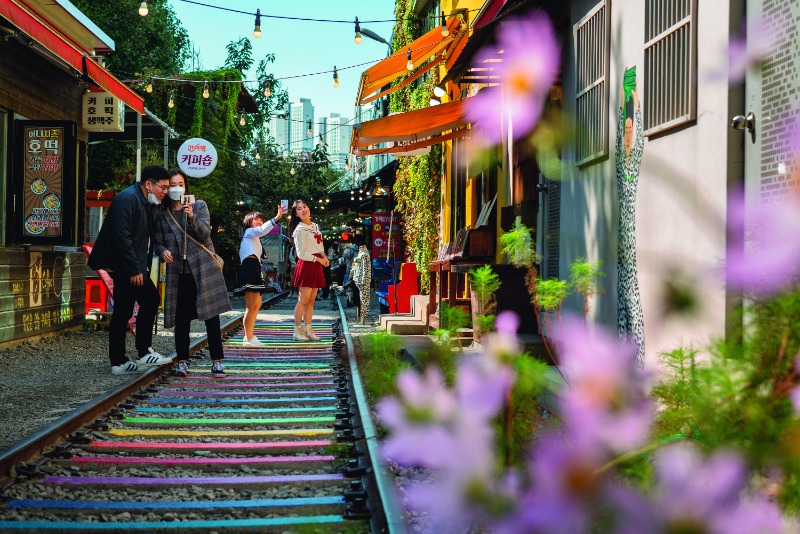
Trains no longer rumble along the 2.5 km stretch of track in Gyeongamdong Railroad Town. Instead, tourists dressed up in old school uniforms walk along the tracks, lined by old houses and shops, recalling their student days.
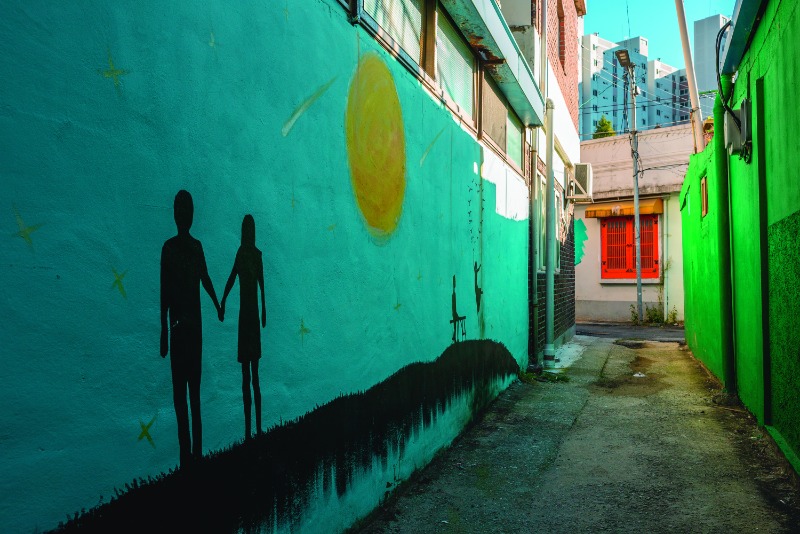
Walking around the city, tourists will often come across lyrical murals adorning winding alleyways. While fancy photo zones are set up at famous tourist attractions, many simple murals evoke warm feelings
The Chae Man-sik Literary Hall has collected more than 200 works written by Chae over some 30 years, including novels, plays, critiques and essays. A Gunsan native son, Chae had great skills for satirically depicting the condition of Korean society before and after national liberation from Japanese rule.
“Story of the Rice Paddy” is one of his most important works. It describes the ordeal of a family living through the turbulent modern era, faced with chaos in the wake of liberation. The protagonist’s father, falsely accused of joining the Donghak Peasant Revolution (1894), is threatened by the authorities: “Do you want to be punished or will you give up your land?” He gives up more than half of his paddies. Under the ensuing colonial rule, the paddies he retained aren’t enough to support the family, so the protagonist sells these to a Japanese – an action considered treacherous by other Koreans. After liberation, he expects the Korean government will recover his land and return it to him. Instead, the government sells it. Through this character who has never had a country that he could call his own, Chae portrayed the confusion of the transitional period and the injustice and mistrust felt by ordinary people.
Chae was one of the few Korean literary figures who really “repented” having sided with Japan. A fter liberation, he wrote the novella, “Transgressor of the Nation” (Minjok-ui joein), serialized in 1948-1949, in which he acknowledged and regretted his pro-Japanese activity. Their outstanding literary value aside, this is how Chae’s works have survived as modern cultural heritage of his hometown.
All over Gunsan, several s of time intermingle. A nation in demise, Japanese occupation, postwar modernization, contemporary high-tech and auto manufacturing – the way these eras mix and yet remain intact is peculiarly inspiring.
Before returning to Gunsan Station, I stopped at Jungdong Hotteok, which has been selling syrup-filled pancakes for 70 years. Transmitted to Korea from the Qing Dynasty of China, hotteok are thin pancakes filled with syrup. Most hotteok are pan-fried, but at this shop they are baked in a brick oven, so they are sweet but not greasy.
Pleasantly nourished and relaxed, I turned my footsteps toward the railroad tracks to return to reality. That clean, sweet taste of being left inside history. It was the taste of Gunsan.
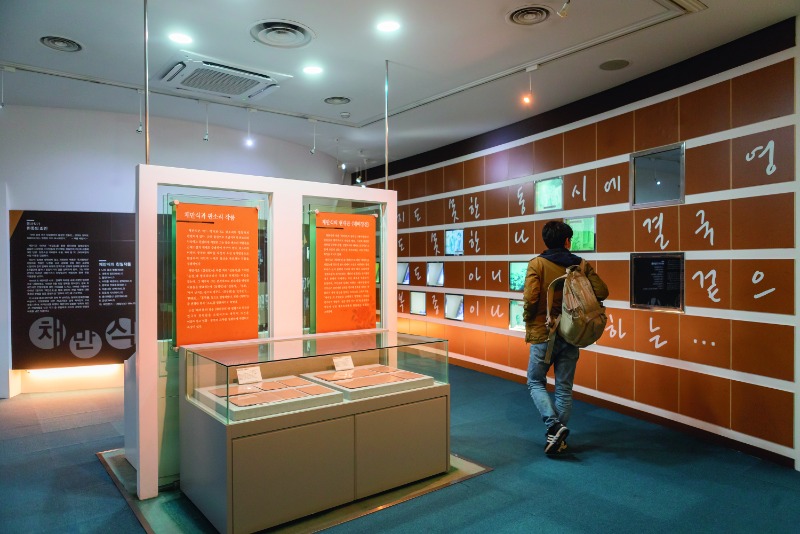
The Chae Man-sik Literary Hall, dedicated to the life and work of one of Korea’s major writers of the 20th century, has an exhibition room, a library and an audio-visual room, as well as a literary-theme walking trail and park outdoors.
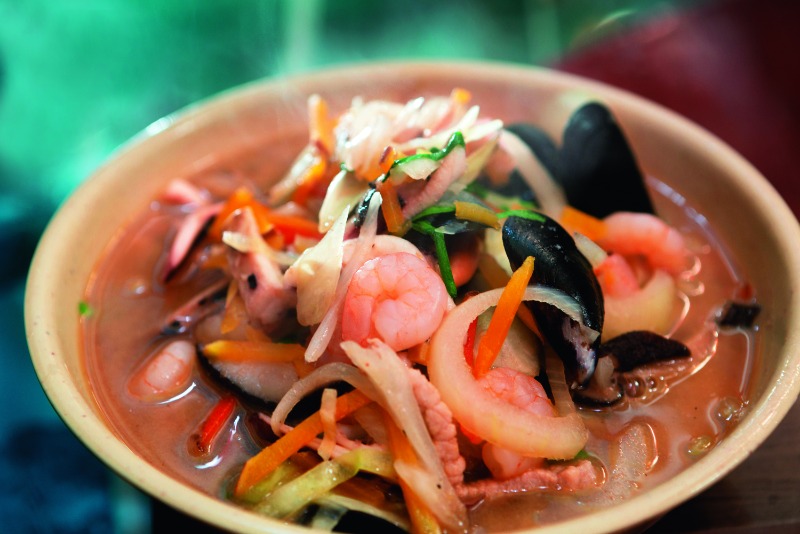
Jjamppong, a spicy noodle soup fusing Chinese, Japanese and Korean cuisine, is a signature dish of Binhaewon. The Chinese restaurant is also known as a shooting location in “The Thieves” (2012), one of the highest-grossing films in Korean movie history.
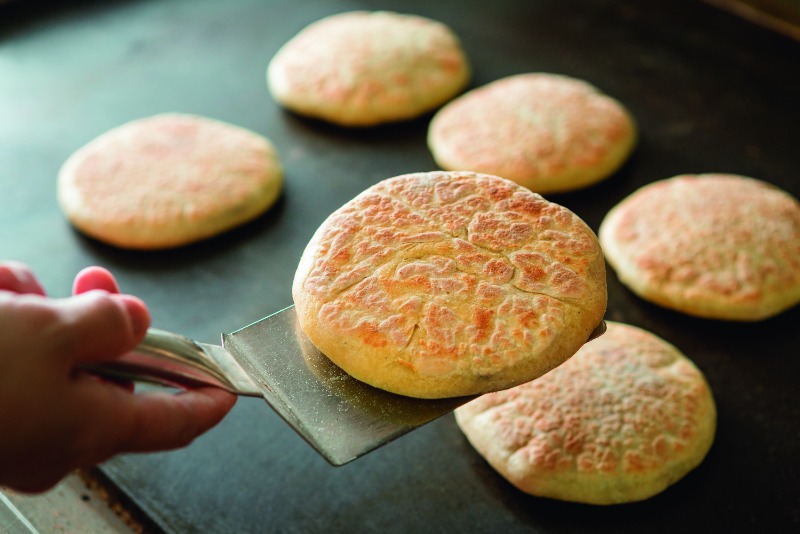
At Jungdong Hotteok, the sweet pancakes are stuffed with a syrupy mixture of Gunsan’s famous glutinous barley, black beans, black rice and black sesame seeds, tasting light and savory.
Park SangNovelist
Ahn Hong-beomPhotographer